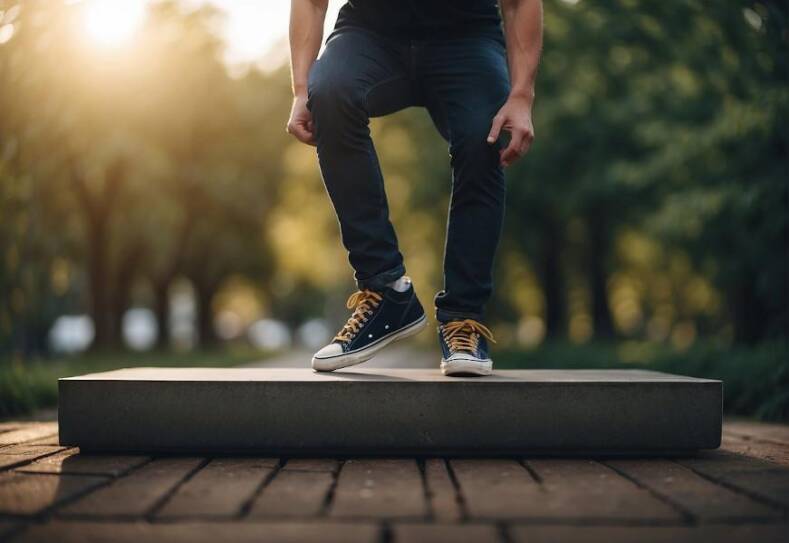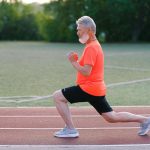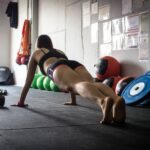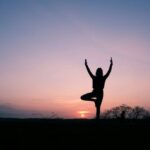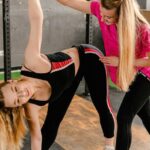Maintaining balance is a crucial aspect of overall health and autonomy, especially as individuals age. Balance exercises are specifically designed to enhance stability, coordination, and posture, which contribute significantly to the quality of life. These forms of physical activity help to strengthen the muscles that keep people upright, including those in the legs and core, and improve the body’s response to potential trips and stumbles.
For adults, engaging in balance exercises can alleviate the risk of falls, which is a common concern for seniors. Incorporating such exercises into a regular fitness routine can also sharpen proprioception, the body’s ability to sense movement, action, and location, which often diminishes with age. Improved balance is shown to correlate with a heightened ability to perform daily activities, promoting independence and confidence.
Balance exercises range from simple techniques, like weight shifts and single-leg balances, to more complex movements found in practices such as tai chi. These exercises can be tailored to suit different fitness levels and can be done with minimal to no equipment. Health professionals often recommend these exercises for their therapeutic benefits, highlighting how a steady routine can reinforce the connections between the nervous system and muscles, crucial for controlling and maintaining balance.
Understanding Balance and Its Importance
Balance is the ability to maintain the body’s center of mass over its base of support. Proficient balance incorporates elements of stability, coordination, and flexibility, which all work in concert to allow individuals to perform daily activities safely and effectively. This capability is not just physical; it involves the brain, as it requires sensory input, processing, and muscle activation.
Why is balance crucial? Maintaining good balance is essential for several reasons:
- Prevention of falls: Adequate balance reduces the risk of falls, which is particularly significant for older adults. Falls can lead to severe injuries and loss of independence.
- Enhancement of posture: Proper balance improves posture, which mitigates the risk of joint and muscle ailments.
- Quality of life: Good balance directly affects one’s quality of life. It allows individuals to move freely and confidently, which is vital for day-to-day activities and overall well-being.
Furthermore, balance exercises support neuroplasticity, the brain’s ability to reorganize itself by forming new neural connections. This adaptability plays a role in enhancing both physical and cognitive skills.
| Aspect | Benefit | Importance |
|---|---|---|
| Stability | Avoids unnecessary wobbling | Essential for performing movements safely |
| Coordination | Syncs muscle groups | Allows smooth, planned movements |
| Flexibility | Extends range of motion | Prevents muscle strain and improves posture |
| Brain | Enhances neural connections | Promotes better cognitive and physical health |
Incorporating balance exercises into one’s regular routine stands as a defense against the impacts of aging, supports injury prevention, and is a strong contributor to a life marked by enhanced mobility and independence.
Fundamental Balance Exercises for Beginners
Beginning balance exercises are crucial for laying a foundation of stability and confidence. They consist of static and dynamic exercises aimed at improving one’s ability to maintain stability during various activities.
Static Balance Training
Static balance training focuses on maintaining a stable position while standing still. One effective exercise is the Flamingo Stand:
- Stand on one leg, using a chair or wall for support if needed.
- Keep the non-supporting leg lifted without letting it touch the standing leg.
- Maintain good posture, with spine, neck, and head aligned.
- Hold the position for 15-30 seconds, then switch legs.
Another basic static exercise involves weight shifts:
- Stand with feet hip-width apart.
- Slowly shift your weight onto your right foot, lifting the left foot off the floor.
- Hold for 15-30 seconds before shifting weight to the left foot.
Dynamic Balance Training
Dynamic balance training involves movement, making the exercises more challenging and engaging. Here are a couple of beginner-friendly exercises:
- Walking Heel to Toe (Tightrope Walk):
- Walk in a straight line with one foot directly in front of the other, as if walking on a tightrope.
- Extend arms to the sides if needed for added balance.
- Focus on a point ahead to maintain good posture.
- Sideways Walking:
- Stand near a wall, using it for support if necessary.
- Step to the side with your right foot, followed by your left foot.
- Move 10 steps to the right and then 10 steps to the left, keeping movements slow and controlled.
Practice these exercises regularly, increasing duration and complexity as balance improves.
Progressive Balance Workouts for Improved Stability
Progressive balance workouts are structured practices that enhance stability through gradual difficulty increments. These routines typically integrate strength training, which in turn fortifies core muscles, and employ specialized equipment to challenge balance.
Balance Training with Equipment
Dumbbells: By incorporating dumbbells into balance exercises, individuals can perform movements that strengthen their stabilizing muscles. A simple yet effective drill is the single-leg balance with dumbbell lateral raises. This exercise mandates the individual to stand on one leg while lifting the weights to the side, engaging both the core and the supporting leg.
Balance Boards and Bosu Balls: To escalate the challenge, balance boards and Bosu balls come into play. A starter exercise could involve standing on a Bosu ball with a slight knee bend, maintaining balance for 30 seconds to a minute.
- Steps:
- Begin with both feet on the equipment.
- Progress to single-leg stances as stability improves.
- Incorporate movements like squats or dynamic exercises.
Table: Recommended Equipment-Based Exercises
| Equipment | Exercise | Primary Muscles Worked |
|---|---|---|
| Dumbbell | Single-leg balance with overhead press | Core, shoulders, legs |
| Balance Board | Stand with controlled movements side to side | Core, legs |
| Bosu Ball | Squats with a bosu ball underfoot | Glutes, core, legs |
Complex Movement Patterns
Balance training often includes exercises that demand complex movements to challenge the body’s coordination and stability further. Tai chi, an exercise form that includes slow, deliberate movements combined with breath control, is one such modality that has been shown to significantly improve balance in various populations, including older adults.
Sample Tai Chi Movements:
- Weight shifts with arm raises
- Controlled single-leg stances, transitioning smoothly between postures
In general, workouts should weave in progressively challenging exercises that require coordination of various muscle groups. For instance, a single-leg balance can evolve into a single-leg deadlift, simultaneously recruiting the hamstrings, glutes, and core muscles.
- Progressions:
- Begin with bilateral exercises; stabilize on both legs.
- Progress to unilateral exercises; stabilize on a single leg.
- Introduce dynamic movement while maintaining balance.
By methodically increasing the complexity and challenge of balance workouts, individuals can effectively enhance their stability, which benefits daily life movements and overall physical performance.
Incorporating Strength Exercises into Balance Training
Strength exercises are foundational to enhancing balance, as they target key muscle groups like the legs, glutes, and hip muscles. For adults intent on boosting their equilibrium, integrating strength-building movements into balance routines offers dual benefits.
Heel-to-Toe Walk: This exercise enriches coordination and activates the lower back and hip muscles. They will walk in a straight line with the heel of one foot touching the toe of the other foot, maintaining a straight posture throughout.
Squats: A quintessential strength exercise, the squat primarily engages the legs and glutes. To infuse a balance component, adults can perform squats on an unstable surface like a BOSU ball or with a narrow stance.
| Exercise | Muscles Targeted | Balance Component |
|---|---|---|
| Squat | Legs, Glutes | Use BOSU ball or narrow stance |
| Heel-to-Toe Walk | Lower Back, Hip Muscles | Perform in straight line |
Lunges: Forward and side lunges are excellent for strengthening the legs and improving stability. For an increased challenge, adults can add a twist at the lunge, which requires the engagement of the core and enhances balance.
In each session, adults should focus on form to maximize the benefit of strength exercises and prevent injury. Proper alignment and controlled movements will ensure they are effectively engaging the correct muscles and challenging their balance.
By incorporating these strength exercises into their balance routines, adults can expect to see improvements not only in muscle resilience but also in their overall stability during daily activities.
Enhancing Coordination and Mobility
Effective coordination and mobility exercises are essential for maintaining an active lifestyle as adults age. These drills and routines are specifically designed to improve overall movement efficiency, reduce the risk of falls, and enhance the ability to perform daily tasks.
Agility Drills
Agility drills aim to bolster coordination, often incorporating rapid changes in direction to improve dynamic balance. A simple drill to start with involves walking in a straight line, placing one foot directly in front of the other, heel touching toe, which mimics a tightrope walk. This drill activates core strength, vital for stability.
Step-Up Exercises:
- Up and Over: Step up onto a low bench followed by a step down to the other side in a continuous motion.
- Lateral Step: Side-stepping over a small object or cone to work on lateral movement.
Mobility Routines
Mobility routines focus on the range of motion within the joints, reducing stiffness, and they are especially beneficial for those with arthritis. Yoga, particularly chair yoga, provides gentle stretching that enhances flexibility and mobility without straining the joints.
Key Movements:
- Chair Pose to Extension: Sit and extend legs forward, then pull back to seated position.
- Leg Lifts: Sitting or standing, lifting each leg maintains hip mobility.
Each exercise should be performed with attention to form, ensuring that any movements, particularly those involving the cardio aspect or rapid motions, are within the individual’s capability. Regular practice can lead to improvements in daily functional movements.
Specific Exercises for Targeted Groups
In the realm of fitness, different age groups and ability levels necessitate tailored exercise regimens. Focusing on seniors and individuals with limited mobility, the following subsections highlight specific balance exercises to enhance stability, bone strength, and endurance while aligning with the recommendations of healthcare professionals.
Balance Exercises for Older Adults
For seniors looking to improve their balance and coordination, it is crucial to perform exercises that prioritize safety and effectiveness. The National Institute on Aging suggests incorporating balance exercises as part of their regular routine to prevent falls and maintain independence.
- Single-Leg Stand: Hold onto a sturdy chair and lift one foot slightly off the ground, holding the position for up to 10 seconds before switching legs. Aim to perform 10 repetitions on each side.
- Heel Raises: Holding onto a chair for support, seniors can strengthen their ankle stability and leg muscles by slowly raising their heels off the ground and lowering them.
Before starting a new workout regimen, older adults should consult with their doctor, especially if they have conditions like arthritis, which might affect their exercise capabilities.
Balance Routines for Those with Limited Mobility
Individuals with limited mobility can also partake in balance-enhancing exercises, modifying as needed to accommodate their range of motion and comfort levels.
- Chair Leg Raises: While seated, slowly extend one leg out straight and hold the position, then lower it back down. This helps engage the core and improve stability. Perform 8 to 12 repetitions per leg.
- Rock the Boat: While standing and holding onto a stable surface, shift weight to one side and lift the opposite foot just a few inches off the floor. Hold for up to 30 seconds, then repeat on the other side.
These exercises offer a form of physical activity that can be adapted to meet individual endurance levels and mobility restrictions. Always ensure that exercises are performed in a safe environment, and if there’s any uncertainty, seek guidance from a healthcare professional.
Lifestyle Tips to Promote Better Balance
Maintaining balance is crucial for overall health and achieving a high quality of life. Regular physical activity is paramount in enhancing balance as it strengthens the body’s core, endurance, and proprioception — the sense of self-movement and body position.
Individuals should incorporate flexibility exercises into their routines to improve muscular range of motion. Activities like yoga or tai chi can be particularly beneficial, as they focus on both flexibility and stability.
Hydration plays a subtle yet vital role in balance. Adequate water intake ensures that all bodily systems function optimally, including those responsible for maintaining equilibrium.
Here’s a quick reference for promoting better balance:
| Lifestyle Tip | Benefit |
|---|---|
| Physical Activity | Enhances core stability and endurance |
| Flexibility Exercises | Improves range of motion and muscular control |
| Proper Hydration | Supports overall bodily functions |
| Breaks During Long Stands | Prevents fatigue and strain |
| Proprioceptive Training | Refines body positioning awareness |
Adults should take frequent breaks during prolonged periods of standing to prevent fatigue, which can increase the risk of falls. If any discomfort or pain is experienced, it’s important to rest and, if persistent, seek medical advice.
Independence in older adults can be safeguarded by adopting these practices, which in turn may lead to a decrease in fall risk and related injuries. Access to safe environments and the utilization of supportive tools, such as handrails, can further promote a safe and balanced lifestyle.
Safety and Adaptation Strategies
When adults engage in balance exercises, especially older adults who have a higher risk of falls, safety is paramount. A doctor should assess an individual’s capacity for certain activities before they start a balance and coordination program, particularly if the person has a history of falls or balance issues.
Balance Training Precautions:
- Consultation: Always consult with a healthcare professional before starting any new exercise regimen.
- Environment: Perform exercises in a safe, hazard-free area to minimize the risk of injury.
- Assistance: Have a sturdy chair or person nearby for support when trying new exercises.
Adaptation to Exercise: As people age, their ears, which play a critical role in maintaining balance, often function less effectively. This makes exercises that strengthen the ears’ vestibular system beneficial along with visual coordination. Older adults should start with basic exercises and gradually incorporate more complex ones, including those that involve an unstable surface, to improve their balance response to real-world scenarios.
Adaptation Strategies:
- Visual Focus: Use exercises that require visual tracking to maintain balance.
- Dual Tasking: Combine cognitive tasks with physical balance activities for better coordination.
- Progressive Difficulty: Start on a stable surface and slowly move to more unstable surfaces as the individual’s ability improves.
To prevent injuries, individuals should always be mindful of their limits and avoid pushing too hard or too fast. Over time, consistent practice of balance exercises can lead to improvements in stability and coordination, reducing the risk of falls and related injuries.
Measuring Progress and Setting Goals
When an individual embarks on a regimen of balance exercises, setting specific goals is paramount to tracking improvement and enhancing quality of life. These goals will act as important milestones in one’s fitness journey. The progress made towards these aims should be quantifiable, such as the number of repetitions for a particular balance exercise or the ability to hold a balance pose for an increasing length of time.
Goal Setting
One can start by identifying clear, attainable objectives, aligned with personal or athletic ambitions. The American Heart Association recommends setting realistic goals to improve overall fitness. For instance, a goal might be to increase balancing time on one foot from 30 seconds to 2 minutes within a certain timeframe.
Tracking Progress
Progress can be monitored using several methods:
- Checklists: Create daily or weekly checklists for completed exercises.
- Performance Logs: Keep a detailed record of exercise types, repetitions, durations, and feelings of stability during and after workouts.
- Doctor Consultations: Regular check-ins with a healthcare provider can ensure exercises are being performed correctly and safely, and they may offer suggestions based on one’s physical health status.
Quality of Life Measurements
Improvements in balance can greatly affect one’s quality of life. Noting enhancements in the ability to perform everyday activities or sports can serve as qualitative indicators of progress.
It is vital to acknowledge that individual results can vary widely, and one should adjust goals as necessary. A consistent and methodical approach to measuring both the objective and subjective aspects of balance exercise progress will result in a clearer picture of physical development.
